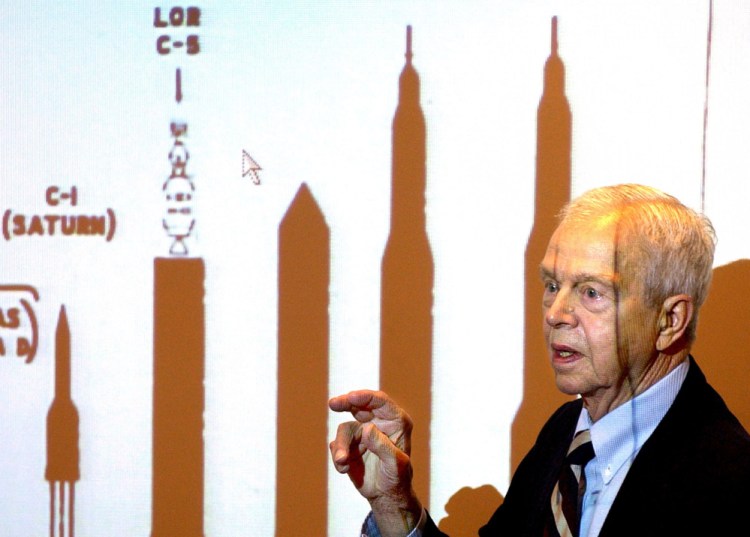April 17, 2014: Aerospace engineer John C. Houbolt, who convinced NASA to use the lunar-orbit rendezvous method to land American astronauts on the moon, dies at 95 in Scarborough, where he has been living in retirement.

Houbolt, who grew up in Iowa and Illinois, was the key figure in a rancorous, protracted behind-the-scenes debate in the late 1950s about how to send space travelers to the moon and back safely and efficiently.
The debate was fractured into three camps – those who favored shooting a big rocket directly at the moon, landing it, and taking off again; those who advocated Earth orbit rendezvous, in which the lunar vehicle would be fired at the moon from Earth orbit; and those who, like Houbolt, concluded that the best option was putting two small vehicles into lunar orbit, sending one to the moon’s surface, and then launching it to meet and dock with the other capsule before returning to Earth.
All three plans were riddled with risky elements. The first option’s biggest flaw was that it required the use of an enormous rocket, much larger than a Saturn V, that had not been developed yet. The second proposal would need at least two Saturn V’s to get all the necessary parts into Earth orbit. The lunar rendezvous plan – proposed long before the United States had even launched a manned capsule, let alone conducted a docking exercise – called for two in-space vehicle dockings. If a crisis ensued, the crew would be too far away to be rescued.
Arguments about which method to choose became especially heated because although Houbolt worked at NASA’s Langley Research Center, he was not on the moon landing project team. German-born Saturn V rocket designer Wernher von Braun became incensed when Houbolt circumvented the supervisory chain of command and made a direct, blunt pitch directly to NASA Associate Administrator Robert Seamans.
Seamans forced consideration of a lunar rendezvous, and by 1962, von Braun became convinced of its merits.
Houbolt left NASA in 1963. Von Braun invited him to the mission control room in Houston to observe the Apollo 11 moon landing in 1969. When Neil Armstrong and Buzz Aldrin’s lunar capsule touched down on the Sea of Tranquility, Houbolt recalled decades later, von Braun turned to him and said, “Thank you, John. It is a good idea.”
Houbolt spent his final days in a Scarborough nursing home, suffering from Parkinson’s disease. According to his obituary, as “a scientist to the end,” Houbolt, with his family’s help, arranged to donate his brain to Massachusetts General Hospital for study of the disease.
Joseph Owen is a retired copy desk chief of the Morning Sentinel and Kennebec Journal and board member of the Kennebec Historical Society. He can be contacted at: jowen@mainetoday.com.
Copy the Story LinkSend questions/comments to the editors.



Success. Please wait for the page to reload. If the page does not reload within 5 seconds, please refresh the page.
Enter your email and password to access comments.
Hi, to comment on stories you must . This profile is in addition to your subscription and website login.
Already have a commenting profile? .
Invalid username/password.
Please check your email to confirm and complete your registration.
Only subscribers are eligible to post comments. Please subscribe or login first for digital access. Here’s why.
Use the form below to reset your password. When you've submitted your account email, we will send an email with a reset code.